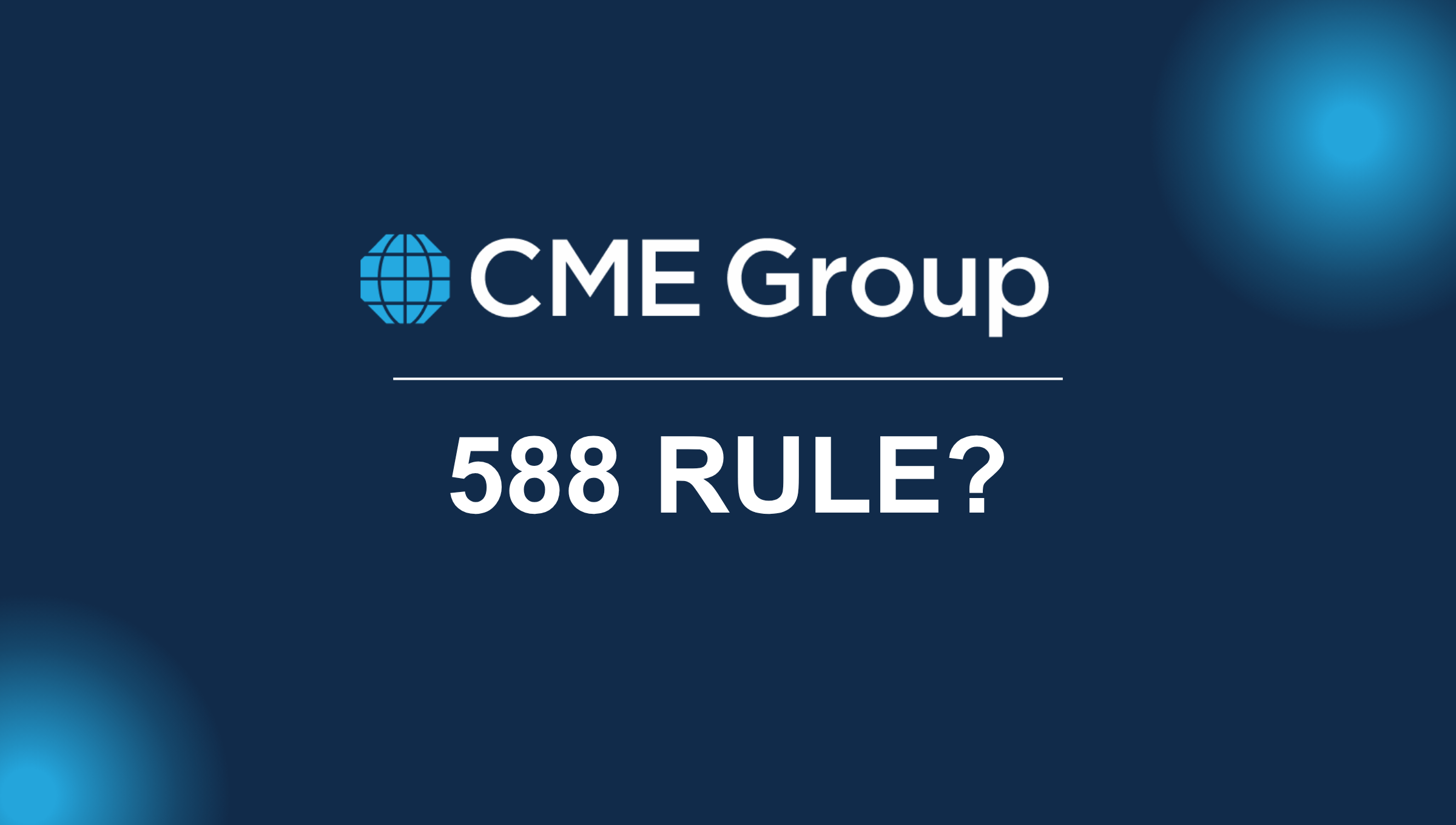CME Rule 588: When the Exchange Can Cancel Your Trades
CME Rule 588 allows the exchange to cancel or adjust trades that harm market integrity. Learn when your trades can get busted and how to protect yourself as an automated trader.

You just made a perfect trade. Caught the move, nailed the exit, locked in a huge profit. Then you get a notification: Trade busted. CME has cancelled your trade under Rule 588, and your profit is gone.
Understanding CME Rule 588—which governs trade cancellations and price adjustments—is critical for any trader, but especially for automated traders and those trading with prop firms where every dollar counts.
Let's continue the conversation from our other articles on Rule 534 and Rule 575, with a breakdown of 588.
What is CME Rule 588?
The Global Command Center may price adjust or cancel trades that are deemed to negatively impact the integrity of the market pursuant to the provisions of Rule 588.
Rule 588 gives CME the authority to:
- Cancel trades (commonly called "busting" trades)
- Adjust trade prices to fair market value
- Review questionable transactions that may harm market integrity
This isn't some obscure rule that never gets used. CME regularly busts trades, and it can happen to anyone.
When Can CME Cancel Your Trade?
CME can bust trades under several circumstances:
1. Obvious Errors
The most common reason for trade cancellations. If a trade executes at a price that's clearly wrong relative to the prevailing market, CME can cancel it.
Example scenarios:
- ES trading at 5,500 and a trade prints at 5,400 due to a fat-finger error
- Someone accidentally hits "market order" instead of limit and gets a terrible fill
- A flash crash causes trades to execute at wildly abnormal prices
2. System Malfunctions
If CME Globex experiences technical issues that result in erroneous trades, those trades can be cancelled.
3. Trades That Violate Exchange Rules
Trades that result from rule violations (like wash trades under Rule 534 or disruptive practices under Rule 575) can be cancelled.
4. Trades That Harm Market Integrity
This is the broadest category. If CME determines a trade or series of trades negatively impacts market integrity, they can intervene.
The No Review Range (NRR)
CME uses something called the "No Review Range" to determine whether a trade qualifies as an obvious error.
For most liquid contracts like ES, NES, and NQ, the NRR is typically a specific number of ticks or percentage away from the reference price (the prevailing market price when the trade occurred).
How it works:
- A questionable trade occurs
- CME looks at what the market was trading at that moment (reference price)
- If the trade is outside the No Review Range, it may be cancelled
- If it's within the NRR, it stands—even if it's a bad fill
The specific NRR values vary by product and are published by CME. For highly liquid products, the ranges are tighter. For illiquid products, the ranges are wider.
Who Can Request a Trade Bust?
Either party to the trade can request a review:
- The buyer
- The seller
- CME Market Regulation (can act on its own)
However, there are strict time limits. You typically have a very short window after the trade (often 15-30 minutes depending on the product) to request a review.
The Review Process
When a trade bust is requested:
- Immediate notification - Both parties are informed a review has been requested
- Analysis - CME examines the trade relative to market conditions
- Decision - CME decides whether to let the trade stand, cancel it, or adjust the price
- Notification - Both parties are informed of the decision
The decision is typically made quickly, often within minutes during market hours.
Price Adjustments vs. Cancellations
CME doesn't always cancel trades outright. Sometimes they'll adjust the price to a "fair market value."
Example:
- You buy 10 ES at 5,400 when the market is trading at 5,500
- Instead of canceling the trade entirely, CME adjusts your fill price to 5,498
- You still get the position, but at a more reasonable price
This approach tries to balance fairness to both parties while maintaining market integrity.
Impact on Automated Traders
Trade busts can be devastating for automated trading strategies:
Risk Management Issues
Your risk calculations assumed a certain P&L. If a trade gets busted, your actual risk exposure changes instantly.
Strategy Disruption
If your algo entered a hedge based on the busted trade, you're now unhedged and exposed.
Prop Firm Rules
Many prop firms count busted trades against your P&L. Even if CME cancels a losing trade that wasn't your fault, the firm might still ding your account.
Critical for prop traders: Check your prop firm's rules on busted trades. Some firms:
- Don't restore your balance if a winning trade gets busted
- Count the initial loss even if the trade is later cancelled
- Have specific policies around trading during volatile periods when busts are more likely
Flash Crashes and Mass Bust Events
During extreme market events, CME can cancel large numbers of trades at once.
Historical examples:
- The 2010 Flash Crash resulted in thousands of busted trades
- Various overnight gaps have resulted in mass cancellations
- System glitches have occasionally caused widespread bust events
If you're holding positions during one of these events, you might wake up to find your trades cancelled and your account in a very different state than you expected.
How to Avoid Getting Your Trades Busted
1. Use Limit Orders in Volatile Markets
Market orders during high volatility are asking for trouble. You might get a terrible fill that you think will be busted, but CME might let it stand if it's within the NRR.
2. Avoid Trading During Known Glitchy Conditions
If you see the market behaving strangely—quotes jumping around, order book looking weird—step aside. Trades during obvious system malfunctions often get busted.
3. Don't Rely on "Free Money" Trades
If you see a quote that's obviously wrong and try to trade it, don't count that P&L as real. It's probably getting busted.
4. Monitor Your Fills Carefully
Use alerts to notify you of fills outside your expected range. The faster you catch an error, the faster you can request a review if appropriate.
5. Understand Product-Specific NRR Values
Different contracts have different thresholds. Know the NRR for the products you trade so you understand when a trade is likely to be reviewed.
What If You're on the Wrong Side of a Bust?
Let's say you sold at a terrible price due to someone else's error, but the trade gets busted. You had a gift, and now it's gone.
You have no recourse.
CME's decision is final and binding. You can't appeal on the basis of "but I would have made money."
The only time you can push back is if:
- CME's analysis was factually incorrect
- The trade was actually within the NRR and shouldn't have been reviewed
- There were procedural errors in the review process
Settlement Price Errors
Rule 588 also covers settlement price adjustments. If CME determines the daily settlement price was calculated incorrectly, they can adjust it.
This affects:
- Your daily P&L
- Margin calculations
- Futures spreads
- Options pricing
Settlement adjustments are rare but can happen, especially in less liquid contracts.
Documentation and Appeals
If you believe a trade was wrongly busted or wrongly allowed to stand:
- Document everything immediately - screenshots, timestamps, market data
- Contact CME Market Regulation - You have a limited window to request review
- Explain your position clearly - Provide evidence of the prevailing market
- Accept the decision - CME's ruling is final; plan accordingly
The Bigger Picture: Market Integrity
Rule 588 exists to maintain fair and orderly markets. Without it:
- Fat-finger errors would cause chaos
- System glitches would bankrupt innocent traders
- Manipulation would be harder to unwind
While it's frustrating when a winning trade gets busted, the alternative, a market where obvious errors stand, would be far worse.
Best Practices for CrossTrade Users
If you're using CrossTrade for automation:
1. Implement Price Reasonability Checks
Don't let your algo submit orders at absurd prices. Build in validation that checks whether your order price is within a reasonable range of the current market.
2. Use Limit Orders
Avoid market orders in automated strategies unless absolutely necessary. Limits protect you from terrible fills that might not get busted.
3. Monitor Fills in Real-Time
Set up alerts for any fills outside expected parameters. The faster you catch an error, the better.
4. Have a Bust Contingency Plan
Your algo should have logic for handling busted trades. What happens to your position? Your hedge? Your risk calculations?
5. Test During Low-Volatility Periods
When you're testing new automation, avoid news events and high-volatility sessions where erroneous fills are more likely.
The Bottom Line
CME Rule 588 gives the exchange the power to cancel or adjust trades that harm market integrity. While this can be frustrating when you're on the wrong side of a bust, it's a necessary safeguard.
For automated traders using platforms like CrossTrade:
- Use limit orders when possible
- Monitor fills carefully
- Have contingency plans for busted trades
- Understand your prop firm's bust policies if applicable
Remember: If a fill seems too good to be true, it probably is and it probably won't last. Don't count P&L from obvious errors as real money, because CME can and will take it back.


